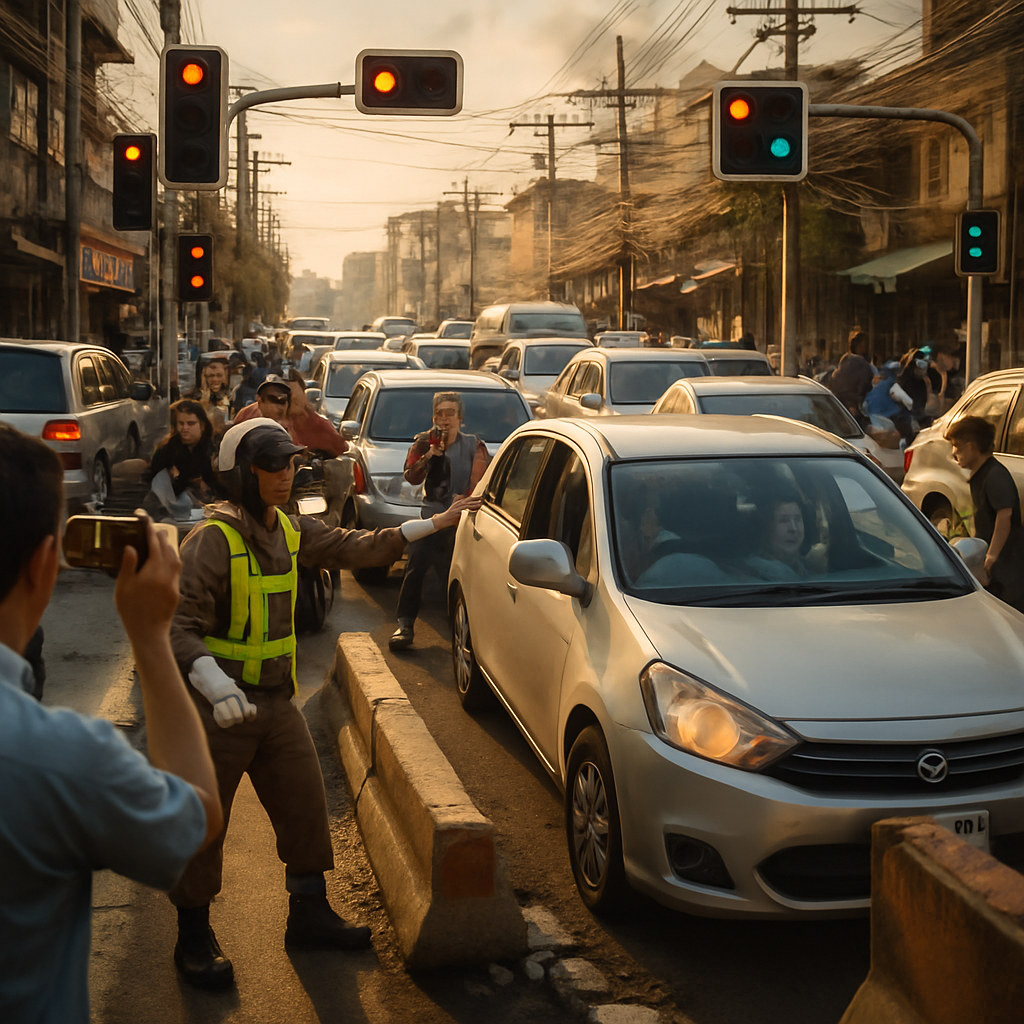The new traffic lights at Pattaya’s Thepprasit–Koh Phai intersection were supposed to be the calm, rational answer to congestion and danger — a city-led trial meant to tame a notoriously tricky junction. Instead, the junction has become a stage for automotive exasperation, social-media theater and a very public argument about whether blinking beacons can replace human common sense.
Drivers and residents have flooded comment threads with tales of gridlock so slow it tests the limits of passenger patience. One fed-up motorist summed it up bluntly: “With three lanes, one for U-turns and one blocked by parked cars, we’re left with just one lane. Traffic barely moves.” Another commuter — a parent who uses the route daily — said it turned a routine school run into an epic: “Today it took two hours to get through an area that normally flows smoothly.”
Those two hours are the kind of detail that makes everyone grimace. You can almost sense the clocks ticking as impatience and irritation build: horns, hand gestures, and the kind of creative lane‑shuffling usually reserved for action movies. The common refrain isn’t merely that the lights are inconvenient; critics say the trial was rushed and under-researched, a digital-age solution plonked down without enough real-world testing.
“This is a classic case of a plan that looks good on paper but fails on the road,” a resident told local outlets. The phrase is hard to argue with when drivers report yellow-light snubs, red-light zone intrusions and the sort of chaotic cross-blocking that makes intersections resemble playgrounds where nobody’s following the rules. “People ignore yellow lights and jump into the red-light zone, causing traffic to block from all directions. It’s chaos,” said one Pattaya resident.
Pedestrians haven’t been spared the fallout. Blocked walkways, uneven footpaths and a general lack of safe crossing points are stacking the risks against anyone on foot. “It’s not just drivers suffering — try walking here. The pavement’s a mess,” a local added. That complaint elevates the issue from commuter annoyance to public-safety problem: a traffic-signal trial loses its social license fast when sidewalk users are endangered or forced to take risky detours.
Not everyone is unsympathetic to the idea behind the lights. A handful of commenters acknowledged the trial’s underlying intent: if it prevents even a single serious accident, the effort has merit. “If this system prevents even one serious accident, it’s a win,” wrote one hopeful commuter — though they were quick to point out that the current timing and layout need serious revision.
So what went wrong? Observers point to several culprits beyond the mere existence of new lights: inadequate enforcement, poor road behaviour, parked cars eating into lane space and a configuration that hasn’t accounted for real driver habits. Critics argue that a little common sense — and some human traffic officers — might have gone farther than a rushed signal installation.
Suggestions bubbling up from the public and reported in local outlets include practical, low-tech fixes as well as engineering tweaks:
- Sync the traffic lights across the three nearby intersections so flow is continuous rather than a stop‑start gauntlet.
- Redesign U‑turn access to avoid a lane being monopolized by turning vehicles.
- Remove or reconfigure medians that create bottlenecks where traffic should be able to breathe.
- Improve enforcement and educate drivers about yellow‑light behaviour to prevent blocking cross traffic.
- Repair and clear pedestrian walkways to protect people on foot and reduce spillover onto the road.
There’s also the old-school option some residents prefer: station human traffic officers during peak hours. A uniformed officer can read a moment’s nuance that a timer cannot, nudging traffic when a lane is clogged or preventing a dangerous wave of red-light incursions. “Sometimes you need humans, not just flashing lights,” said one local.
City officials now find themselves under growing pressure to reassess the trial or scrap it altogether. Residents insist that any solution must be grounded in how people actually behave on the road, not just how engineers imagine they will. In a town as traffic‑prone as Pattaya, theory must be tested against the messy reality of parked cars, impatient drivers and families trying not to be late for school.
In the meantime, the Thepprasit–Koh Phai intersection remains a microcosm of a wider problem cities face worldwide: the tension between automated fixes and human unpredictability. Whether the lights will be retimed, redesigned or replaced by officers with whistles and reflective vests, one thing is clear — Pattaya’s residents want a solution that moves people forward, not one that keeps them stuck, staring at a blinking red and wondering where the common sense went.


















They put the lights in like a bandage on a broken bone and now everything is worse. It feels like the planners never stood at the junction during rush hour. Someone needs to admit the trial failed and fix it fast.
Admit failure? That will never happen until someone gets hurt badly or the tourism numbers drop. Meanwhile we sit in jam and watch drivers take ridiculous risks.
Exactly, Ann. If it takes a crash for them to act then that’s too late. I suggested simple cones and an officer for mornings but no one listens.
Cones sound cheap and effective but officials love gadgets that show they’re modern. It’s political theater more than engineering sometimes.
The pedestrian issues are what scare me most. Sidewalks blocked, no safe crossings, and kids forced to squeeze past cars. Lights without safe walkways are pointless.
Tell me about it. I saw a mother carry her toddler across a curb because the crossing was full of parked cars. That’s a lawsuit waiting to happen.
We need immediate enforcement of parking rules. Clear walkways first, then adjust signals. Protecting pedestrians should be priority.
Some people say the lights are useful, but if parked cars take a lane then any system fails. Who’s enforcing parking here anyway?
Nobody enforces squat. You pay a little fine or bribe and keep going. Until that changes, any infrastructure is undermined.
I don’t want to sound cynical but enforcement is the root problem. Even brilliant signal timing can’t solve deliberate rule-breaking.
This is classic: top-down tech fixes with zero behavioural study. You can’t automate away human unpredictability without studying humans first.
Two hours for a short stretch? That’s insane. I had to turn around and take back roads that were worse. Signals need retiming and human direction at peaks.
Exactly, Joe. A uniformed officer could sort chaotic moments in five minutes. The timer can’t see that a bus is hogging the U-turn lane.
Glad you agree. I know people who avoid Thepprasit now and that’s bad for businesses along the road.
But hiring officers costs money and causes traffic too. Maybe a volunteer program could help during school hours.
I actually think the idea had merit if done right. Syncing the lights and redesigning the U-turn bays could help, but they rushed implementation.
From a traffic-engineering perspective, signal coordination and proper lane allocation are essential. But you must collect volume, turning-movement and pedestrian data before changing phase plans.
Great point Dr. Park. The city should publish pre- and post-trial data so the public can see what metrics they used.
Seems like a governance problem. If the transport department outsourced installation without local consultation, of course it fails. Participation matters.
People forget that traffic systems are socio-technical. You can’t just add hardware and expect culture to change. Education campaigns should run alongside trials.
Education is key but takes years. Short-term measures like temporary marshals and clear signage could bridge the gap while people learn.
Yes, marshals during the first month would buy time and reduce accidents while drivers adapt to the new layout.
Blinking beacons are a blunt instrument. The V/C ratio and critical lane volumes must inform cycle lengths; otherwise inefficiencies are amplified. This reads like poor project management.
Agreed. Also consider protected phases for pedestrians and U-turn bays with separate signal heads. Planners should model scenarios before field trials.
Exactly. Simulation tools are cheap and fast. It boggles me that they went straight to field hardware without iterative simulation.
I live nearby and the worst is the yellow light. People treat it like green or red as they prefer. A short amber is causing panic accelerations and blocking.
Short amber is deadly. Extend amber and add clearance intervals. The timing looks like they tried to squeeze more throughput but failed safety tests.
Thanks Lucky. I hope officials listen to those technical suggestions instead of PR statements.
Also the medians force weird weaving. Remove or redesign them so vehicles don’t bottleneck. Engineers need to hack the geometry, not just signals.
Removing medians sounds dangerous without proper study. But chokepoints do need smoothing. Maybe a temporary re-striping trial first.
Yes Ann, temporary re-striping with cones can test the flow without permanent work. Low-cost and fast data.
Some commenters here are quick to blame drivers, but drivers are reacting to cues. If the system cues chaos, they will act chaotic. Fix the cues.
As a school teacher, I see kiddos almost get hit because cars queue onto crosswalks. If the trial prioritizes vehicle flow without pedestrian protection it’s ethically wrong.
TeacherTom, that hits home. My neighbor’s kid almost got clipped last week. We should pressure the school board and city together.
Yes Somchai, community pressure works sometimes. A petition and emails to the mayor might get a human officer stationed there.
Tourists also get confused by odd U-turn rules. This junction is a bad look for Pattaya’s image. Clarity matters for visitors and locals alike.
People saying ‘just put officers’ ignore corruption risk and staff shortages. You need a combined approach: enforcement, redesign, and public info.
Corruption is real but that’s not an excuse to do nothing. Independent auditors and body cams for officers could help transparency.
True, Larry. Transparency measures would make human direction more acceptable to skeptical residents.
I just want my food delivery to arrive on time. These trials make drivers take longer and that hits small businesses. Think about the ripple effects.
Funny how every solution becomes everyone’s job except those who approved the trial. Hold the decision-makers accountable at the next council meeting.
Some folks online defend the lights, saying accidents were common before. Maybe the truth is mixed and we need better data transparency from the city.
Data transparency would settle many arguments. Publish counts, delays, crash stats and enforcement logs. Let independent experts analyze the numbers.
I filmed three drivers ignoring the red when I passed. Uploaded it and got accused of overreacting. People will only change when fines bite.
Why not temporary cameras to warn and fine offenders during the trial? Automated enforcement could discourage red-light incursions quickly.
Automated enforcement helps only if calibration is transparent and appeals processes exist. Wrong tickets will erode public trust.
Good point. Any camera program should be paired with public notices and a short grace period before fines start.